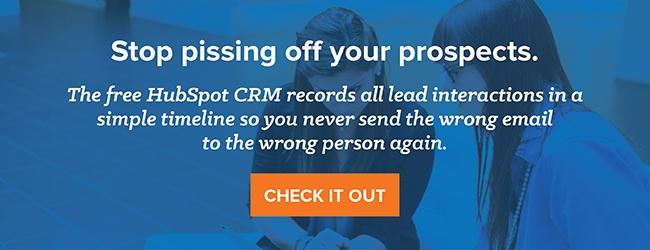
Even with the rise of social media and the ubiquity of business email, a phone conversation is usually still the best method of communication, especially for selling and buying. But that doesn't mean salespeople should ignore the preferences of their prospects by insisting on a phone call right away.
I think the phone is a superior way to communicate with prospects when I'm selling. But when I'm researching solutions, my personal preference is email. I've been on the receiving end of too many bad sales calls, and between scheduling the call and having to have introductory chit-chat, it takes way too long to get to the point where we're talking about what I want to talk about.
Even when I try to help salespeople on an introductory phone call, they still often stink. Often, they're unable to deviate from their scripted questions and stories. Worse, their agendas are usually painfully obvious and in opposition to mine.
So when I'm investigating a solution and know roughly what I want, it's more efficient for me to ask for what I think I need in an email. Since I readily admit what I don’t know, I'm also more than willing to answer questions over email. You'd think this would make salespeople's lives easier, since I'm literally spelling out my goals. But many reps are so blindly focused on "booking that call" that they miss opportunities to engage and help over email.
What Happens When Reps Ignore Buyers' Communication Preferences
When I started a free trial of a service the other day, I experienced the perfect example of a salesperson completely missing and/or ignoring my preference for email. After browsing the site to try and figure out if the service could help me, I saw a free trial button and completed the form. I was expecting to get instant access to the free trial. No dice. I left the site disappointed and ended up using a competitive offering instead because it offered a full-featured 30-day trial.
An hour later, I received this note from an SDR at the first company after his call rolled to voicemail. (I don't answer my phone any more.)
Peter,
I was unable to reach you on the phone, but wanted to discuss your eligibility for free trial access to <software> – I have some time this afternoon, give me a call directly at my number below.
Regards,
Joe

While this isn't Joe's fault, this company clearly uses a bait-and-switch approach to free trials. Not a good start. I wrote back: "If I'm not eligible, that's okay. I'll find another source. Going with <competitor> now."
Joe responded:
Hey Peter,
We do have a few different trials so I was just hoping to learn a bit more about your specific needs to set you up in the best direction for your evaluation. Is there a good time this week for a brief discovery call?
Regards,
Joe

I didn't believe there was actually more than one trial, so I got straight to the point and sent Joe a five-sentence description of what I was trying to accomplish. I asked him point-blank whether I'd be able to complete that project within his product.
The use case for the product is quite simple, and a short video or article could have showed me how to complete my project. Instead of trying to help me, Joe completely ignored my question and passed me off to an enterprise sales rep with the following email:
Peter,
Based on your needs I think <company> will be a great fit. I am not on the sales team, but I am connecting you with my colleague, Bob, who can field any questions you have and facilitate your <product> evaluation from here. I have CC’ed Bob on this email.
Regards,
Joe

Joe copied and pasted our previous correspondence, so Bob should have known that I didn't want to get on a phone call. You can probably guess what happened. Instead of asking how I'd like to proceed, Bob called me, left a voicemail, and then followed up with an email asking, "What time works best to hop on a call?" What really annoyed me is the level of presumption that exists in that question.
I finally responded to Joe and Bob with the following, “Was hoping to just get access to a free trial. The link I clicked wasn't 'free trial after we qualify you.'”
But Bob was relentless. He wrote back:
Peter,
We always like to better understand our prospects' needs before getting them access. I have absolutely no problem getting you set up with access. I’ll have you up and rolling with access, and you should receive an email tomorrow with login credentials.
I’ll be your point of contact at <company>, please feel free to reach out to me if you have any questions. I would still like to schedule a call to better understand the business need – what time works best for you?
Regards,
Bob

Three emails later, I finally got access to the trial -- 30 hours after I'd originally signed up for one. In that time, I was asked to get on a phone call five times.
When I finally logged into this company’s trial, the interface was easy enough to understand. I figured out that it could ultimately do what I wanted to do, but when I tried to test the functionality for the first time, I was shown a CTA to call a phone number because I "exceeded my limit." I realized the only thing this company lets you trial is their interface.
I reached back out to Joe with the following email:
Joe,
I have a very simple project I'm trying to do. It has nothing to do with the core selling team at HubSpot, so this is not an enterprise sales opportunity for you.
If you're interested in helping me, here's what I'm trying to do: <explanation>
I figured out how to do Y. But, when I tried to do X, I was told to call for pricing.
I have little interest in a phone call. But if you want to help me, here's a few questions:
- Question 1
- Question 2
- Question 3
Feel free to tell me to go away if this isn't a fit. You guys are clearly trying to sell an ongoing use case for a bigger team. But this is just me and I only have a short-term need for your product.
Pete

Bob responded:
Peter,
We do support organizations from a larger enterprise level – this project does not sound like a fit.
Best of luck in your search,
Bob

So, where did this go wrong?
As an aside, this company's trial process is way behind their competitors'. The only thing I'll say is this: if this company is going to continue offering a trial, they need to teach their reps how to sell with it, not against it. Waiting 30 hours to get access while the reps try to book a qualification call is a ridiculously dated bait-and-switch approach.
With regards to Bob's sales strategy, it seems he was only interested in immediate enterprise sales opportunities. I have the title of someone who can decide to purchase his product -- or at least influence it. While I wasn't interested in a larger relationship at the present time, there's no telling how HubSpot's needs could change down the line, and Bob seemingly had no interest in developing a relationship that could lead to a bigger deal in the long run.
Bob also failed to adapt his strategy to the situation. Don't get me wrong -- I've been known to say, "Get them on a phone call" to my sales reps many a time. Like I said above, a live call is a superior communication tool for a salesperson trying to differentiate their product or service, so I understand why Bob wanted to run discovery over the phone. But I clearly didn't want to take a phone call, just like many prospects.
Asking me five times to have a call didn't work. Bob should have taken a different tack much sooner. What could he have done differently? He could have asked me a few questions about my need, told me how I could have accomplished it (or that I couldn’t), or offered to walk me through how to accomplish it in the trial. Here’s what an effective note from Bob might have looked like:
Hey Pete,
Received your trial request. So that I can help you get the most out of the trial, would you like to:
- Explain to me how you were hoping to use our product?
- Get on a call so I can quickly show you how you can accomplish what you’re trying to do in the trial?
- Ask me any questions you have so that I can help you figure out if our service is a good fit or not for you?
I am available for a call if that is easier for you. Here’s a link to my calendar if you’d like to schedule time. <link>
Regards,
Bob

Ironically, any of the questions above might have gotten me on a call. The email I drafted would have demonstrated Bob's willingness to help, which would have gotten me to drop my guard. I had already started explaining what I was trying to do over email and would have elaborated if I'd been asked, which would have given Bob the option of giving me a product walkthrough or disqualifying me. Instead, their process is way too focused on getting me on a call to qualify whether there is an enterprise opportunity or not.
The big takeaway from this experience is that salespeople need to be a lot less rigid about their own communication preferences and adapt to the buyer.
Here are are a few tips for determining and adapting to your buyer’s communication preference.
1) The way buyers initiate communication or respond to you is an indication of their preference.
Today, many sales conversations start over email. Most prospects don't answer the phone or return voicemails. Nevertheless, since phone is better and there’s no way of knowing a prospect’s preference, the best salespeople still just pick up the phone and try to catch prospects. They also leave voicemails. But if a prospect responds by email, that it is a good indication that email is their preference. If they call you back, the phone is probably their preference. If they respond via InMail on Linkedin or direct messages on Twitter, go with that approach for awhile.
2) Always send a follow-up email after you leave prospecting voicemails.
This gives prospects an easier way to respond if email is their preference. Even though their notes were ineffective, Bob and Joe did send follow up emails. Despite the outcome of the process, this still kept me engaged.
3) Ask buyers their communication preference.
When I’m selling, I tend to write, “I’m available by phone if that’s easier for you.” It’s not exactly a question, but if they write me back over email instead of scheduling a call, I now have a clue of what their preference is. I never write, “When can you get on a 15-minute call?”
4) Include your calendar link in your email.
Write, “Here is a link to my calendar where you can schedule time directly if you’d like.” Also include that link in your email signature. That way, prospects can schedule time easily if that’s their preference. You’re making it easier for them to choose phone without even asking them. The Meetings app in HubSpot Sales can streamline this process for you. Here's what it looks like:
One caveat: If a prospect writes you back, it’s okay to just call them. Once a prospect responds by email, there is nothing wrong with dialing and starting the conversation with, "Figured it'd be easier to talk over the phone. Do you have five minutes?"
If they don't give you permission to proceed, ask, “How can I best help you evaluate our ability to meet your needs?” If they don't pick up the phone, don't make "Can we schedule 15 minutes?" your next ask over email. If you make that your call to action, you’ll miss an opportunity to engage them in a dialog over email. Instead, consider asking an open-ended question about their interest and just offering to get on a call if that’s more convenient for them.
One word of caution: Be especially careful not to assume your preference is theirs. Be careful not to swing too far in the other direction and assume that email is your prospects' preference just because it's your preference. This post isn't supposed to be proof that email is a better communication method. The crucial thing to remember is to pay attention to your buyer's preferences and adapt accordingly. Use their preferred method of communication effectively and you'll have the opportunity to gain credibility and increase the chances of them realizing it's worth it to get on a call with you.
Everybody Is Different, And That’s Okay
My wife says “Everybody is different, and that's okay,” to my son Peter when he expresses a preference for something different.
In all aspects of life, it's important to be tolerant of other people’s differences. It’s a sign of respect and appreciation for a fellow human being. This type of appreciation is key to initiating a relationship with someone new -- say, like a buyer. So why don’t salespeople respect the communication preferences of their prospects?
Maybe salespeople think that their preference is more important. Maybe they’ve been instructed to ignore their prospect’s preferences. Maybe they've had just enough luck with prospects saying "sure, let's get on a call."
Whatever the reason, the status quo is clear. Bob (and many other salespeople) don’t seem to understand that in sales, their own communication preferences don’t matter.
Adapt to Your Buyer or Lose the Opportunity
In an email exchange with Trish Bertuzzi the other day, she wrote to me, "Email is not my communication vehicle of choice. I am a phone girl. Are you shocked?" I was not shocked since she is the founder of inside sales consulting group, The Bridge Group and the author of the Sales Development Playbook, and she understands the power of the phone. So now I (and you) know Trish's preference. But most buyers won’t be as upfront as Trish is. It’s your job to read your prospects' behavior to maximize your chances of connecting. You can’t make sales if you can’t get past this part of the process.
Use the tips above to uncover your prospect's communication preferences and adapt your approach based on what you uncover.
P.S. I always respond to blog comments. Feel free to disagree.










![Why Your Company Should Invest in Inbound Sales During a Recession [Expert Insights]](https://www.hubspot.com/hubfs/Recession%20inbound%20%281%29.jpg)